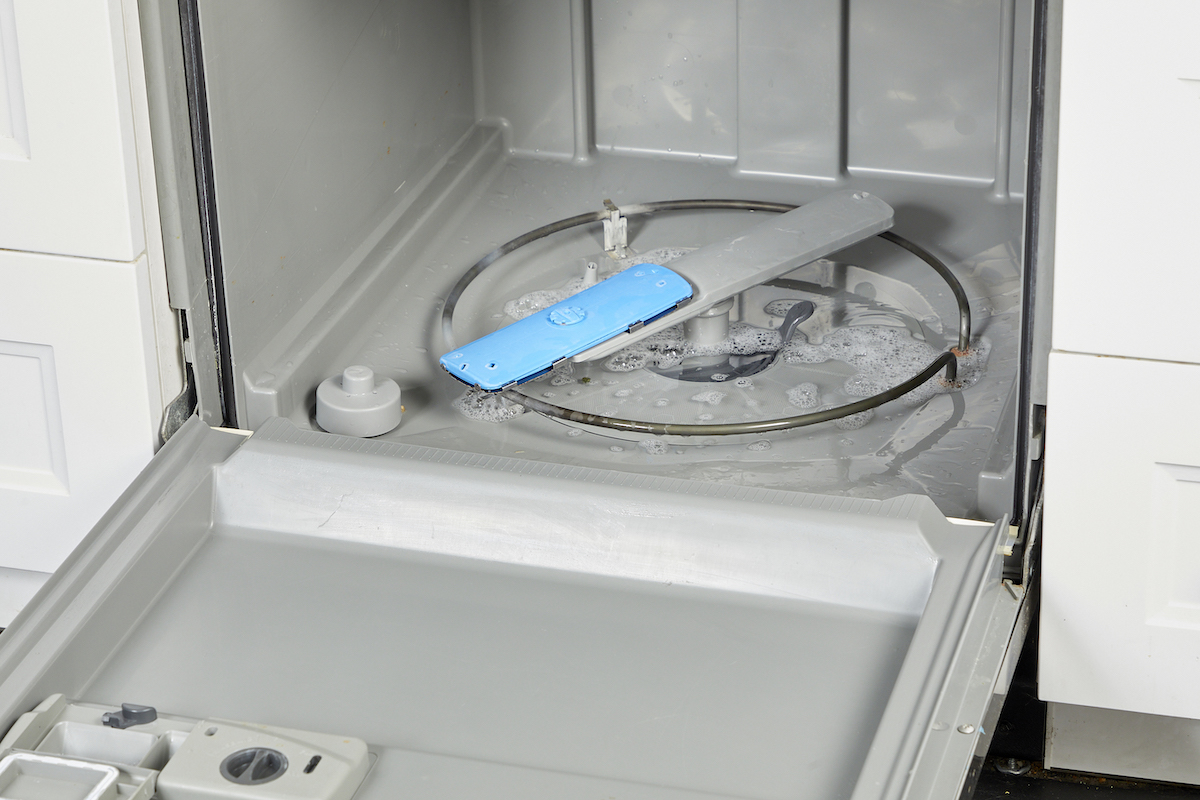

We may earn revenue from the products available on this page and participate in affiliate programs. Learn More ›
It’s not uncommon to find a little water sitting in the bottom of the dishwasher at the end of a cycle. But if you open the door and see more than a cup or so of water in the bottom of the dishwasher, or if the base of the tub is completely filled with water, the appliance may not be draining properly.
Some problems are more common than others. According to Glenn Lewis, president of Mr. Appliance, a Neighborly Company, “One of the most common causes of a dishwasher not draining properly is a clogged filter or drain hose [that’s] caused by placing dishes in the dishwasher without thorough removal of food…especially fibrous food.”
Before you call in a repair professional, try these steps to troubleshoot your dishwasher. The easiest tips are listed first.
Make sure the dishwasher has completed its cycle.
When a dishwasher is stopped mid-cycle, the water doesn’t have a chance to drain. If you think this may be the reason why water has accumulated, try running a complete cycle again to see if the water drains. If the water is not emptying from the dishwasher, move on to the next step.
Activate the “cancel” feature, or reset the appliance.
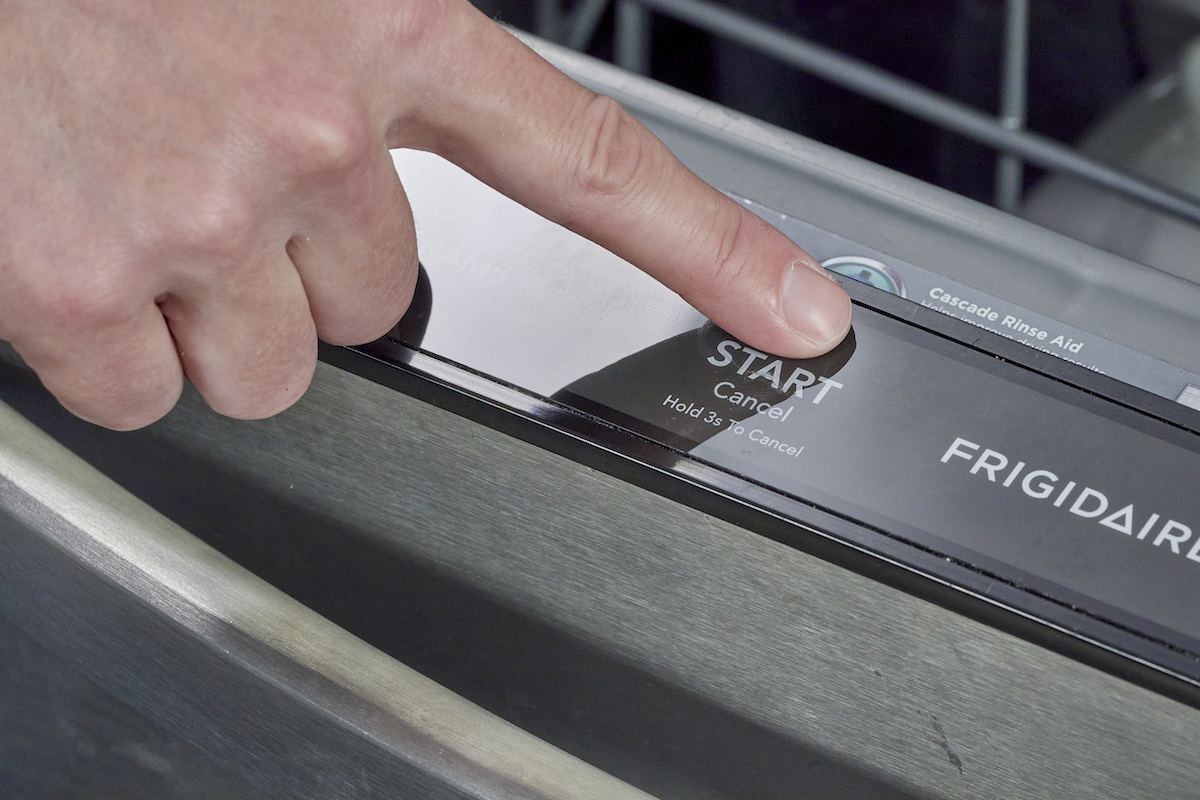
When your dishwasher won’t drain, you may be able to get the water flowing again by using the dishwasher’s cancel feature. Depending on the brand and model you own, either hold down the Cancel (or Cancel/Drain) button, the Start (or Start/Drain) button, or a Reset button for 3 seconds (check the manual). Alternatively, you can reset the dishwasher by unplugging it or shutting off power at the breaker and waiting a few minutes before restoring power.
If canceling or resetting doesn’t work, the cause might be a clog or a broken pump, and you’ll need to try another fix. Even if a cancel or reset does empty the tub, you may notice standing water again after the next time you run a cycle. If that happens, you will need to look deeper for a solution.
Run the garbage disposal.
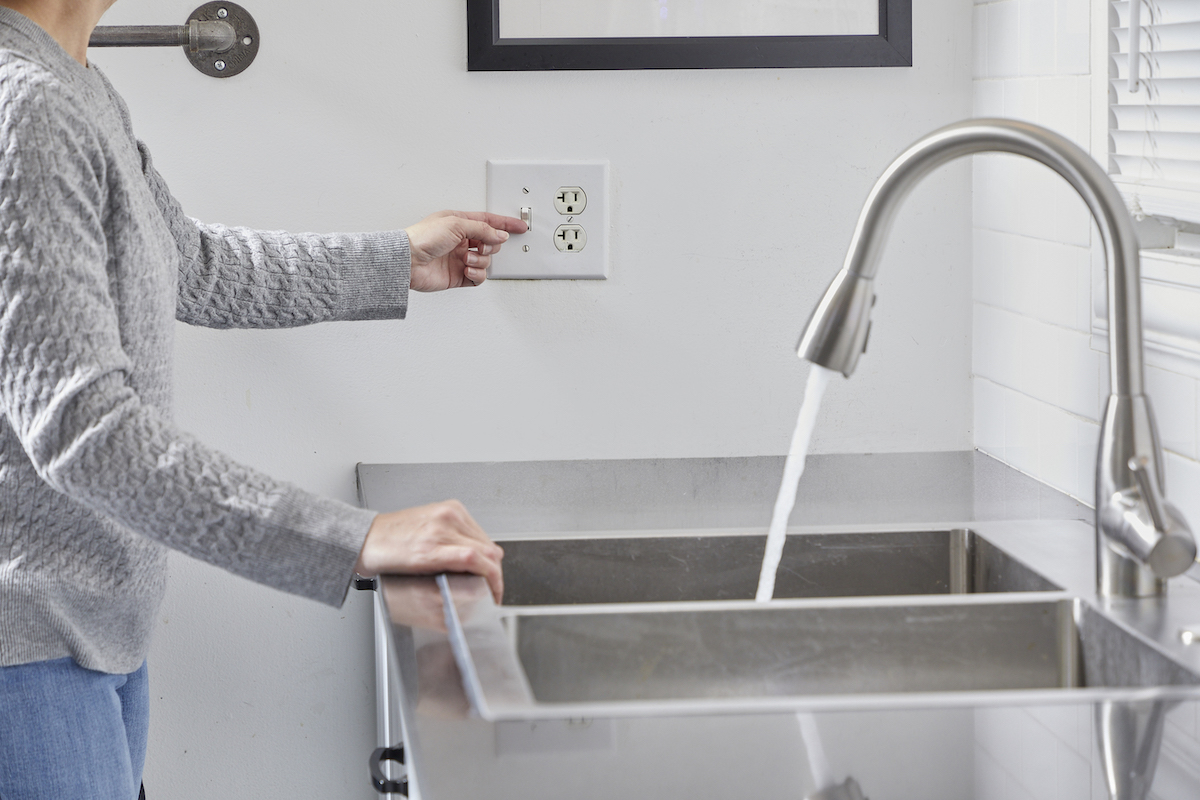
The drain hose from your dishwasher empties into your garbage disposal, if you have one. If the disposal unit contains unground food or if food sludge has settled in the drainpipe below the disposal, it can prevent even the best dishwasher from draining properly. Running the disposal may be all it takes to get the dishwasher draining again.
To keep this from happening, get into the habit of running the disposal (and the water) for an additional 15 seconds after the grinding sound has stopped. This helps to clear out food that might otherwise remain in the P-trap drain beneath the disposal.
Remove standing water.
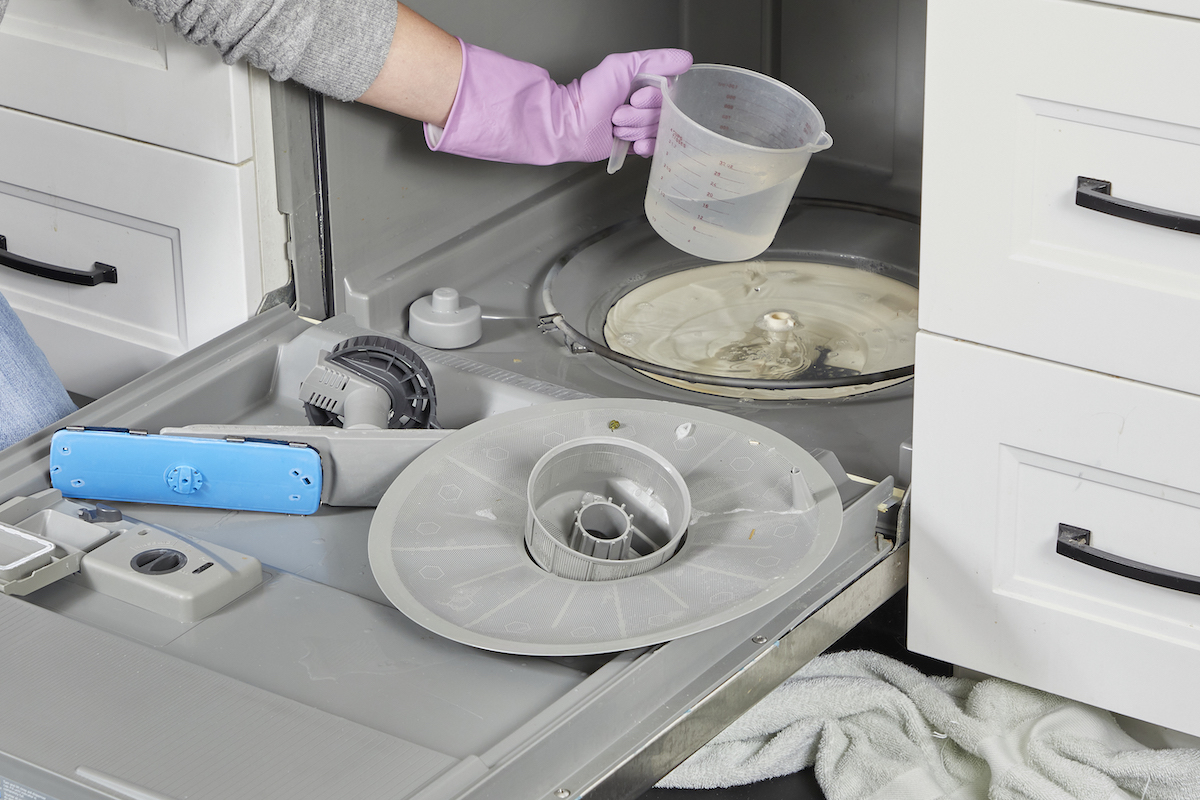
If running the disposal doesn’t help drain the water (or if you don’t have one), you’ll need to figure out how to drain the dishwasher so you can take a closer look at other possible issues.
- Place absorbent towels around the base of the dishwasher and remove the bottom dish tray by sliding it out.
- With the tray out of the way, use a plastic cup to scoop the dirty, foul-smelling dishwater into a bucket for disposal.
- When the water level is too low to scoop, use towels to sop up the remaining water at the bottom of the dishwasher tub.
Clean out the drain basket.

The drain basket is often the culprit of a smelly, clogged dishwasher. It’s found at the base of your dishwasher, usually below the bottom rack. Its cover often resembles an upside-down basket, which either snaps off or is held in place by one or two screws. If the bottom of your machine doesn’t look like this, consult your owner’s manual, which you can usually download from the manufacturer’s website.
Remove the cover and check for food buildup in the basket beneath. Some dishwashers will have a filter you can remove and clean. Use your hand or a spoon to remove debris, replace the cover, and run the dishwasher through a cycle.
Note: If you’re constantly clearing out the drain basket, you can prevent future dishwasher clogs by pre-rinsing, or at least scraping food off, your dishes. Some dishwashers feature macerators that grind bits of soft wet food, but these don’t have nearly the power of a garbage disposal. A quick scrape before you put a dish on the rack can help keep the drain basket or filter cleaner.
Check the dishwasher drain hose for kinks.
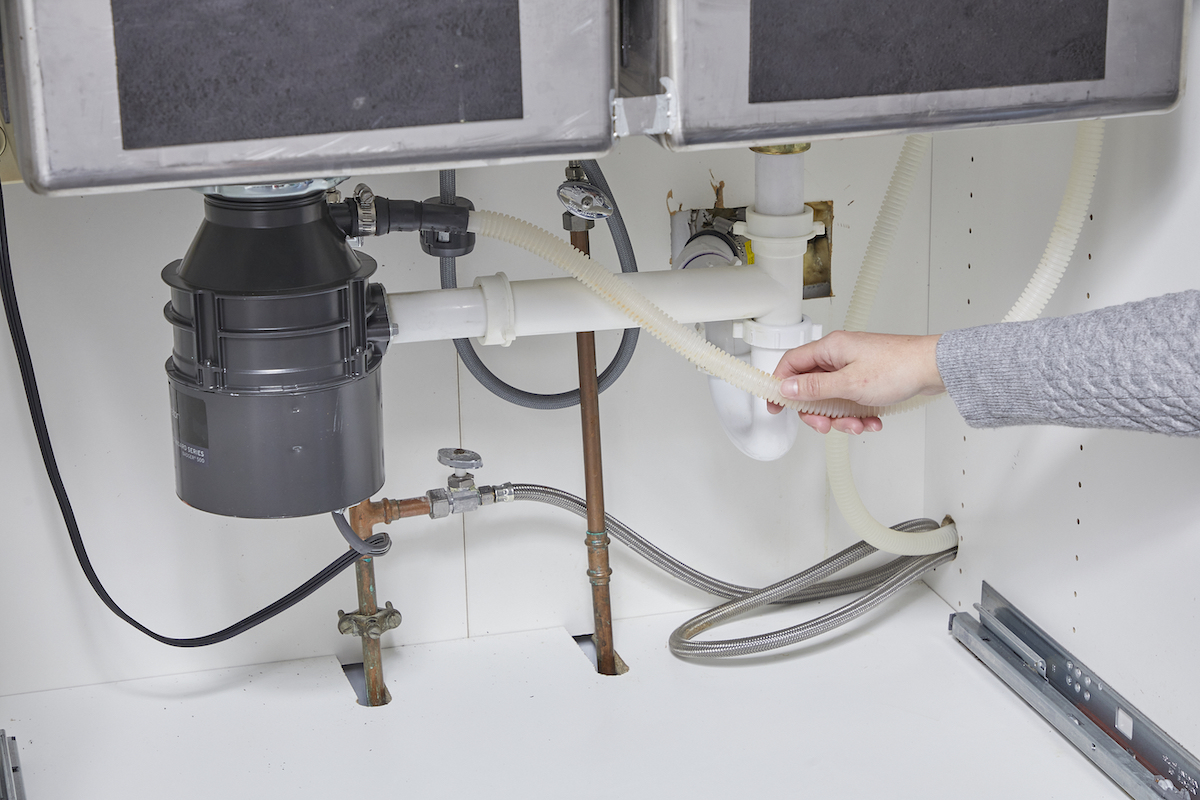
If the easy fixes above don’t work, check for problems with the drain hose. Open the under-sink cabinet and examine the configuration of the corrugated dishwasher drain hose and how it connects to the sink drain. The following drain connections are the most common.
- High loop to disposal: In this configuration, the dishwasher drain hose enters the cabinet from the dishwasher and loops to the top of the cabinet, where it’s held in place by some sort of strap, tape, string, or chain, and then connects to the garbage disposal.
- High loop to drain: If there is no garbage disposal, the dishwasher drain hose will still have a high loop but will connect to the sink’s drainpipe. The connection must be before the P-trap on the drain line; if it isn’t, sewer gases can enter the dishwasher and leave a stinky smell.
- Air gap to disposal: In this configuration, the hose runs to the top of the cabinet just as in the high loop, but instead of being held in place by a strap or chain, the hose connects to a cylindrical fitting mounted on the sink. The fitting has two branches: one for the dishwasher drain hose and one for a hose to the garbage disposal. An air gap in the fitting prevents dirty sink water from traveling back to the dishwasher.
- Air gap to drain: The hose from the air gap connects to the sink drainpipe (before the P-trap) instead of to the garbage disposal.
A kinked drain hose—the lightweight, corrugated plastic hose that connects the dishwasher drain pump to the garbage disposal, sink drainpipe, or air gap—can prevent water from draining out of the dishwasher. Check in the under-sink cabinet to see if the hose is kinked. (Perhaps something large or heavy was shoved under the sink and kinked the hose, or maybe something is still pushing against it.) If it’s kinked, straighten it out manually.
Unfortunately, once a drain hose kinks, it tends to happen again in the same spot, so you may want to replace the drain hose. It’s a simple DIY task—keep reading for details.
Examine the drain hose for clogs.
If the hose isn’t kinked, it could still be clogged with food sludge or debris. To check for a clog, you’ll need to remove the lower front panel of the dishwasher and locate the spot where the corrugated hose attaches to the dishwasher drain pump.
First, unplug the dishwasher or cut off the power supply at the breaker. (In general, when working on appliances, cut the power first.) Place old towels under the unit and then remove the lower front panel. Many panels snap off, but depending on your model, you may have to remove a screw or two. Disconnect the hose from the pump. (If you’re not sure how to disconnect it, consult the owner’s manual.)
To check the hose for clogs, simply blow through it. If air won’t pass through, you’ve got a clog. If the clog is located at either end of the hose, you can try to carefully remove it with a screwdriver or other thin implement, like a straightened-out wire coat hanger.
If the clog is not located near the end connected to the pump, remove the hose where it connects to the garbage disposal or air gap to check for a clog on that end. If the clog is lodged deeper, you’ll probably have to replace the entire hose. Don’t try to clear the clog with a plumber’s snake—dishwasher hoses aren’t designed to withstand that tool’s cutting motion and can be easily punctured.
Replace the drain hose.
For recurring kinks or a clog that you can’t remove, replace the entire hose. Call a plumber if you’re not comfortable doing this yourself. A pro could easily charge $150 just to check things out, so you’ll save money by making the repair yourself.
Start by unplugging the unit and sliding it out from under the countertop. Disconnect the old hose from both the pump and the garbage disposal (or air gap), and attach the new one in the same manner. Consult your owner’s manual to ensure you purchase the correct replacement hose and for specific instructions on how it attaches to your model.
Clean the dishwasher air gap.
In most cases, a drain connection with a dishwasher air gap is the least likely type to have problems. Whether or not your dishwasher has one depends mostly on local building codes. Some municipalities require air gaps, but others require only a high loop connection under the sink cabinet.
Occasionally, an air gap can become clogged with debris. This can prevent the dishwasher from draining correctly and it can leave standing water in the dishwasher. To investigate, remove the stainless steel cover from the air gap and then remove (or unscrew) the cap covering the tube. Look into the air gap and check for debris or gunk. Clear it out with water and a small, stiff brush. Replace the cap and stainless cover, and run a dishwasher cycle to see if the fix worked.
Clean up detergent mishaps.
Dishwashers are designed for use with automatic dishwasher detergents that clean without producing suds. It’s certainly possible to accidentally squirt regular dishwashing liquid into the unit, and this could create enough suds to prevent proper draining. A similar problem can occur if you substitute laundry detergent in a pinch. If you’ve made either of these mistakes, simply bail out the tub as described above, and run another cycle, this time using the correct dishwasher detergent.
Call the plumber.
Most of the time, one of the above techniques will repair the problem of extra water collecting in your dishwasher. But if you’ve tried all these tips and the dishwasher isn’t draining, the problem could lie in a faulty dishwasher pump or in the dishwasher’s timer or motherboard. Some of these repairs should be done only by a licensed plumber, so it’s probably time to call a pro.
Final Thoughts
Most of the time when you’re stuck with a dishwasher not draining, the remedy is simple and inexpensive. A backed-up garbage disposal or clogged drain basket may be preventing water from draining out of the machine. There may be a kink or clog in the drain hose or the air gap is blocked. These are some of the common issues a homeowner can fix. However, the best strategy is prevention. “One effective tip to help clean out minor blockages and keep the system clean is running white vinegar or a cleaner designed to clear buildup through the dishwasher,” Lewis recommends. Also, running the garbage disposal regularly and clearing out the drain basket can keep clogs at bay. If your brand of dishwasher does not have a macerator, or food grinder, it can also help to either pre-rinse dishes or at least remove large chunks of food to keep the drain basket clear.
FAQs
You might be able to clean a dishwasher drain hose by pouring 1 cup of baking soda and 1 cup of white vinegar in the machine’s drain and letting it sit for up to 15 minutes before flushing with hot water and running a rinse cycle. This usually works only for clogs in the hose near the drain.
First, try running the disposal and rerunning the dishwasher cycle. If that doesn’t remove the water, bail it out and proceed with the troubleshooting tips above.
Do not use Drano to clear a clog in a dishwasher. Drano is caustic and can damage a dishwasher’s rubber seals and plastic pipes as well as the drain pump.
If you open the dishwasher after a cycle and see a lot of standing water, it’s possible that the drain pump isn’t working. Other signs of a problem with the pump include a loud noise or a buzzing noise when the pump should be operating. Note that sometimes the issue is a small foreign object stuck in the impeller or pump, so taking the assembly apart and removing the object may solve the problem.
To help prevent the drain hose from getting clogged, it’s important to clean the interior of the dishwasher at least once a month. This involves cleaning the filter/drain basket, wiping down the interior to remove debris, and running an empty cycle with a glass containing 2 cups of white vinegar in the bottom rack. You can also try cleaning the dishwasher drain with vinegar and baking soda as described above.
While most drain pumps cost between $30 and $100, the cost of having someone replace a drain pump typically runs around $150 to $400.
Replacing a dishwasher pump can be a DIY job, but the ease of the repair depends largely on the dishwasher model you own and your repair skills. You will need to disconnect the electricity and shut off the water supply to the appliance, assemble the right tools (most likely flat- and Phillips-head screwdrivers, channel-lock pliers, and a nut driver set), and pull the dishwasher out from the countertop. Accessing the drain pump may require flipping the dishwasher onto its back.
